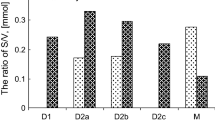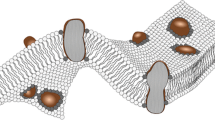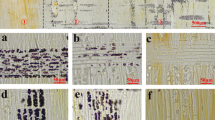Abstract
Although most of the wood cells which are produced in the cambium die after the deposition of secondary wall thickening and lignification, the parenchymous cells contain living substances throughout the sapwood and are used for transportation and storage of metabolic materials. In the electron microscope dark globular particles of different sizes were traced from cambium to heartwood border in the parenchymous cells of pine. In the sapwood-heartwood transition zone the dark particles loose their globular shape and the dark content is deposited upon the parenchymous cell wall and therewith upon the membranes of the window-like pits. In this state the membranes are darkly colored so that it is assumed that the dark materials diffuse into the membranes. Dark deposits were observed within the compound middle lamella, in the chambers of bordered pits, and within the fiber lumina. From these observations it is concluded that the dark substances migrate through the middle lamella into the pit chambers and from there into the cell lumina. There is evidence that the decomposition of the globular particles as well as the diffusion of the dark substances into the cell walls begin in a region which is macroscopically considered to be part of the sapwood. Subsequent reactions in the deposition places result in the formation of typical heartwood substances.
Similar content being viewed by others
References
Bauch, J.,Liese, W.,Scholz, F. 1968. Über die Entwicklung und stoffliche Zusammensetzung der Hoftüpfelmembranen von Längstracheiden in Coniferen. Holzforsch.22: 145–153.
Bosshard, H. H. 1966. Notes on the biology of heartwood formation. IAWA News Bull. (1): 11–14.
Côté Jr., W. A.,Krahmer, R. L. 1962. The permeability of coniferous pits demonstrated by electron microscopy. Tappi45: 119–122.
Dietrichs, H. H. 1964. Das Verhalten von Kohlenhydraten bei der Holzverkernung. Holzforsch.18: 14–24.
Fengel, D. 1968. Zur Variation der Hoftüpfelgestalt bei verschiedenen Nadelhölzern. Holz Roh-Werkstoff26: 296–304.
—,Bednar-Baldermann, E. 1968. Polymerisierbare Verbindungen als Einbettungsmittel für die Ultramikrotomie. Teil 2: Anwendung und Vergleich bekannter und neuer Einbettungsgemische. Mikroskopie23: 220–237.
Frey-Wyssling, A.,Bosshard, H. H. 1959. Cytology of the ray cells in sapwood and heartwood. Holzforsch.13: 129–137.
Hillis, W. E. 1968. Chemical aspects of the heartwood formation. Wood Sci. Technol.2: 241–259.
Huber, B.,Merz, W. 1958. Über die Bedeutung des Hoftüpfelverschlusses für die axiale Wasserleitfähigkeit von Nadelhölzern. Planta51: 645–672.
Hugentobler, U. H. 1965. Zur Cytologie der Kernholzbildung. Vierteljahresschrift Naturforsch. Ges. Zürich110: 321–342.
Jayme, G.,Hunger, G.,Fengel, D. 1960. Das elektronenmikroskopische Bild des Cellulosefeinbaues verschlossener und unverschlossener Hoftüpfel der Nadelhölzer. Holzforsch.14: 97–105.
Krahmer, R. L.,Côté Jr., W. A. 1963. Changes in coniferous wood cells associated with heartwood formation. Tappi46: 42–49.
Liese, W. 1965. The fine structure of bordered pits in softwoods. In:Côté Jr., W. A. (Ed.): Cellular ultrastructure of woody plants. Syracuse, N. Y.: Syracuse University Press, 271–290.
—,Bauch, J. 1967. On the closure of bordered pits in conifers. Wood Sci. Technol.1: 1–13.
Palade, G. E. 1952. A study of fixation for electron microscopy. J. Exp. Med.95: 285–298.
Preusser, H. J.,Dietrichs, H. H.,Gottwald, H. 1961. Elektronenmikroskopische Untersuchungen an Ultradünnschnitten des Markstrahlparenchyms der Rotbuche —Fagus sylvatica L. Holzforsch.15: 65–75.
Ruthmann, A. 1966. Methoden der Zellforschung, Stuttgart: Francksche Verlagshandlung, 102.
Thomas, R. J.,Nicholas, D. D. 1968. The ultrastructure of the poinoid pit in southern yellow pine. Tappi51: 84–88.
Ziegler, H. 1964. Storage, mobilization and distribution of reserve material in trees. In:Zimmermann, M. H. (Ed.): The formation of wood in forest trees. New York, London: Academic Press, 303–320.
— 1968. Biologische Aspekte der Kernholzbildung. Holz Roh-Werkstoff26: 61–68.
Author information
Authors and Affiliations
Rights and permissions
About this article
Cite this article
Fengel, D. Ultrastructural changes during aging of wood cells. Wood Sci.Technol. 4, 176–188 (1970). https://doi.org/10.1007/BF00571852
Received:
Issue Date:
DOI: https://doi.org/10.1007/BF00571852




